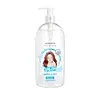What's inside
What's inside
 Key Ingredients
Key Ingredients

 Benefits
Benefits

 Concerns
Concerns

 Ingredients Side-by-side
Ingredients Side-by-side

Water
Skin ConditioningHexylene Glycol
EmulsifyingPEG-7 Glyceryl Cocoate
EmulsifyingNiacinamide
SmoothingDecyl Glucoside
CleansingButylene Glycol
HumectantPropanediol
SolventPhenoxyethanol
PreservativeMannitol
HumectantGlycerin
HumectantXylitol
HumectantAllantoin
Skin ConditioningCetrimonium Bromide
AntimicrobialPanthenol
Skin ConditioningPropylene Glycol
HumectantSalicylic Acid
MaskingCucumis Sativus Fruit Extract
EmollientEthylhexylglycerin
Skin ConditioningPotassium Hydroxide
BufferingCentella Asiatica Extract
CleansingBiosaccharide Gum-2
Skin ConditioningTetrasodium EDTA
Caprylic/Capric Triglyceride
MaskingPotassium Azeloyl Diglycinate
Skin ConditioningDeoxyphytantriyl Palmitamide Mea
Skin ConditioningHydrogenated Lecithin
EmulsifyingCeramide NP
Skin ConditioningCholesterol
EmollientPotassium Chloride
Caprylyl Glycol
EmollientChlorphenesin
AntimicrobialWater, Hexylene Glycol, PEG-7 Glyceryl Cocoate, Niacinamide, Decyl Glucoside, Butylene Glycol, Propanediol, Phenoxyethanol, Mannitol, Glycerin, Xylitol, Allantoin, Cetrimonium Bromide, Panthenol, Propylene Glycol, Salicylic Acid, Cucumis Sativus Fruit Extract, Ethylhexylglycerin, Potassium Hydroxide, Centella Asiatica Extract, Biosaccharide Gum-2, Tetrasodium EDTA, Caprylic/Capric Triglyceride, Potassium Azeloyl Diglycinate, Deoxyphytantriyl Palmitamide Mea, Hydrogenated Lecithin, Ceramide NP, Cholesterol, Potassium Chloride, Caprylyl Glycol, Chlorphenesin
Ingredients Explained
These ingredients are found in both products.
Ingredients higher up in an ingredient list are typically present in a larger amount.
Butylene Glycol (or BG) is used within cosmetic products for a few different reasons:
Overall, Butylene Glycol is a safe and well-rounded ingredient that works well with other ingredients.
Though this ingredient works well with most skin types, some people with sensitive skin may experience a reaction such as allergic rashes, closed comedones, or itchiness.
Learn more about Butylene GlycolChlorphenesin is a synthetic preservative. It helps protect a product against bacteria in order to extend shelf life. In most cases, Chlorphenesin is paired with other preservatives such as phenoxyethanol and caprylyl glycol.
Chlorphenesin is a biocide. This means it is able to help fight the microorganisms on our skin. It is also able to fight odor-releasing bacteria.
Chlorphenesin is soluble in both water and glycerin.
Studies show Chlorphenesin is easily absorbed by our skin. You should speak with a skincare professional if you have concerns about using Chlorphenesin.
Learn more about ChlorphenesinEthylhexylglycerin (we can't pronounce this either) is commonly used as a preservative and skin softener. It is derived from glyceryl.
You might see Ethylhexylglycerin often paired with other preservatives such as phenoxyethanol. Ethylhexylglycerin has been found to increase the effectiveness of these other preservatives.
Glycerin is already naturally found in your skin. It helps moisturize and protect your skin.
A study from 2016 found glycerin to be more effective as a humectant than AHAs and hyaluronic acid.
As a humectant, it helps the skin stay hydrated by pulling moisture to your skin. The low molecular weight of glycerin allows it to pull moisture into the deeper layers of your skin.
Hydrated skin improves your skin barrier; Your skin barrier helps protect against irritants and bacteria.
Glycerin has also been found to have antimicrobial and antiviral properties. Due to these properties, glycerin is often used in wound and burn treatments.
In cosmetics, glycerin is usually derived from plants such as soybean or palm. However, it can also be sourced from animals, such as tallow or animal fat.
This ingredient is organic, colorless, odorless, and non-toxic.
Glycerin is the name for this ingredient in American English. British English uses Glycerol/Glycerine.
Learn more about GlycerinPropanediol is an all-star ingredient. It softens, hydrates, and smooths the skin.
It’s often used to:
Propanediol is not likely to cause sensitivity and considered safe to use. It is derived from corn or petroleum with a clear color and no scent.
Learn more about PropanediolWater. It's the most common cosmetic ingredient of all. You'll usually see it at the top of ingredient lists, meaning that it makes up the largest part of the product.
So why is it so popular? Water most often acts as a solvent - this means that it helps dissolve other ingredients into the formulation.
You'll also recognize water as that liquid we all need to stay alive. If you see this, drink a glass of water. Stay hydrated!
Learn more about Water